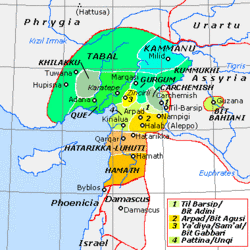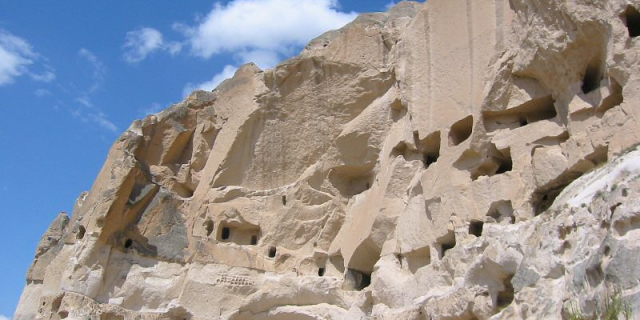Tyana (Ancient Greek: Τύανα), earlier known as Tuwana during the Syro-Hittite period, and Tuwanuwa under the Hittite Empire, was an ancient city in the Anatolian region of Cappadocia, in modern Kemerhisar, Niğde Province, Central Anatolia, Turkey. It was the capital of a Luwian-speaking Neo-Hittite kingdom in the 1st millennium BC.
 The Hittite Empire, with Tuwanuwa located in the Lower Land.
The Hittite Empire, with Tuwanuwa located in the Lower Land.The city of Tuwanuwa was first mentioned in the texts of the Hittite Empire, where, according to the Telipinu Proclamation, Tuwanuwa had been ruled by the sons of the 17th century BC founder-king of the Hittite Old Empire, Labarna I.[1]
According to later Hittite sources, Tuwanuwa was an important cult centre.[2]
During the reign of the Hittite Middle Empire's king Tudhaliya III, the cities of Tuwanuwa and Uda had become border towns of the forces of Arzawa after it had invaded the Lower Land. The prince Suppiluliuma fought a battle against the Arzawan forces near Tuwanuwa and recaptured Tuwanuwa, which then became a base from which the Hittite forces reconquered the Lower Land from Arzawa.[3]
 Tabal among the Neo-Hittite states. Tuwana was one of the constituent states of Tabal.
Tabal among the Neo-Hittite states. Tuwana was one of the constituent states of Tabal.Tuwana[5]

PhrygianReligion Luwian religionKing
After the collapse of the Hittite Empire, Tuwananuwa became the centre of the Syro-Hittite state of Tuwana[1] (Akkadian: 𒆳𒌅𒄩𒈾, romanized: Tuḫana) in the region of Tabal, in whose southernmost regions it was located.[6] The kingdom of Tuwana covered the territory which later in Classical Antiquity was called Tyanitis, and it extended to the south until the Cilician Gates.[7]
Tuwana was a state whose population was descended from the largely Luwian inhabitants of the former Hittite region of Tuwanuwa,[6] and it was also the largest and most prominent kingdom of southern Tabal, with its territory consisting of several settlements surrounding the royal capital at the city of Tuwana,[1][6] although the city of Nahitiya might have temporarily acted as capital under the reign of the king Saruwanis.[8]
Tuwana might have been ruled by a single dynasty consisting of the kings Warpalawas I, followed by his son Saruwanis, who was succeeded by his own son Muwaḫaranis I, himself succeeded by his son Warpalawas II, whose son and successor was Muwaḫaranis II.[1][9]
The longest reigning king of Tuwana was Warpalawas II, who was mentioned in the records of the Neo-Assyrian Empire as one of five kings who offered tribute to Tiglath-Pileser III in 738 and 737 BC.[1][10]
Tuwana was a powerful state under Warpalawas II, under whose reign it contained one sub-kingdom whose capital was at the site corresponding to present-day Porsuk, and whose ruler Tarḫunazas declared himself to be the "servant" of Warpalawas.[9][10]
By the time of the Neo-Assyrian king Sargon II, Tuwana was one of the last still independent Tabalian kingdoms, although it was coming under the pressure of both the Neo-Assyrian Empire and the kingdom of Phrygia because of its location between these two powers,[1][10] and some Old Phrygian inscriptions on basalt, possibly dated from Warpalawas II's reign, as well as the Phrygian robe depicted as worn by Warpalawas II in his Ivriz monument, suggest that aspects of Phrygian culture were arriving into Tuwana during the late 8th century BC in the time of Warpalawas II.[11]
Warpalawas II nevertheless appears to have carried out a policy of cooperation with the Neo-Assyrian Empire, thanks to which he was able to keep his throne until the c. 700s BC.[11] And, after Sargon II had reorganised the kingdom of Tabal after deporting its king Ambaris in 713 BC, he increased Tuwana's authority over Tabalian territory.[1]
 İvriz relief, depicting Warpalawas II (smaller, on the right) worshipping the Storm-god Tarḫunza (taller, on the left)
İvriz relief, depicting Warpalawas II (smaller, on the right) worshipping the Storm-god Tarḫunza (taller, on the left)The last known king of Tuwana is Muwaḫaranis II, the son of Warpalawas II.[1][10]
List of kings of Tuwana Warpalawas I ? (r. c. early 8th century BC) Saruwanis (r. first half of 8th century BC) Muwaḫaranis I (r. ? – c. 740 BC) Warpalawas II (r. c. 740 BCE – 705 BC) Muwaḫaranis II (r. c. late 8th century BC – unknown)Greek and Roman periods Artifacts from Tyana in Niğde Archaeological Museum
Artifacts from Tyana in Niğde Archaeological Museum Tyana archeological site
Tyana archeological site Roman Aqueduct of Tyana
Roman Aqueduct of Tyana Roman Aqueduct of Tyana
Roman Aqueduct of TyanaBy the Graeco-Roman period, the city became known as Tyana (Ancient Greek: Τυανα, romanized: Tuana; Latin: Tyana), and the country around it as Tyanitis.[2]
In Greek legend, the city was first called Thoana because Thoas, a Thracian king, was its founder (Arrian, Periplus Ponti Euxini, vi); it was in Cappadocia, at the foot of the Taurus Mountains and near the Cilician Gates (Strabo, XII, 537; XIII, 587).
Xenophon mentions it in his book Anabasis, under the name of Dana, as a large and prosperous city. The surrounding plain was known after it as Tyanitis.
It is the reputed birthplace of the celebrated philosopher (and reputed saint or magician) Apollonius of Tyana in the first century AD. Ovid (Metamorphoses VIII) places the tale of Baucis and Philemon in the vicinity.
According to Strabo the city was known also as "Eusebeia at the Taurus". Under Roman Emperor Caracalla, the city became Antoniana colonia Tyana. After having sided with Queen Zenobia of Palmyra, it was captured by Aurelian in 272, who would not allow his soldiers to sack it, allegedly because Apollonius appeared to him, pleading for its safety.
Late Roman and Byzantine periodsIn 372, Emperor Valens split the province of Cappadocia in two, and Tyana became the capital and metropolis of Cappadocia Secunda. In Late Antiquity, the city was also known as Christoupolis (Greek: Χριστούπολις, "city of Christ").[12]
Following the Muslim conquests and the establishment of the frontier between the Byzantine Empire and the Caliphate along the Taurus Mountains, Tyana became important as a military base due to its strategic position on the road to Cilicia and Syria via the Cilician Gates, which lie some 30 km to the south.[12] Consequently, the city was frequently targeted by Muslim raids. The city was first sacked by the Umayyads after a long siege in 708,[12][13] and remained deserted for some time before being rebuilt. It was then occupied by the Abbasid caliph Harun al-Rashid in 806. Harun began converting the city into a military base and even erected a mosque there, but evacuated it after the Byzantine emperor Nikephoros I bought a peace.[14]
The city was again taken and razed by the Abbasids under Al-Abbas ibn al-Ma'mun in 831.[15] Abbas rebuilt the site three years later as an Abbasid military colony in preparation for Caliph al-Ma'mun's planned conquest of Byzantium, but after Ma'mun's sudden death in August 833 the campaign was abandoned by his successor al-Mu'tasim and the half-rebuilt city was razed again.[16]
The city fell into decline after 933, as the Arab threat receded.[12] The ruins of Tyana are at modern Kemerhisar, three miles south of Niğde;[12] there are remains of a Roman aqueduct and of cave cemeteries and sepulchral grottoes.





















Add new comment